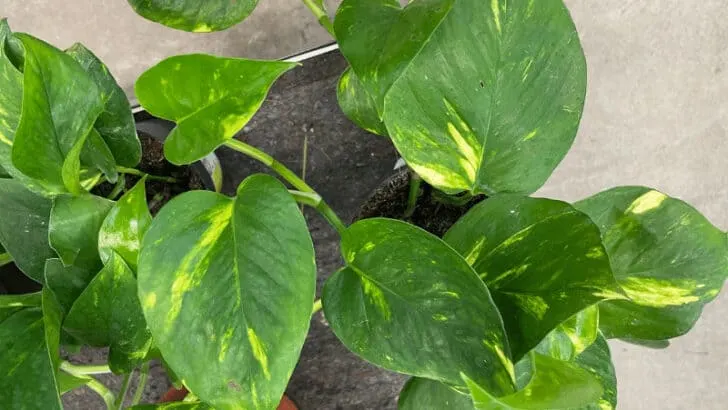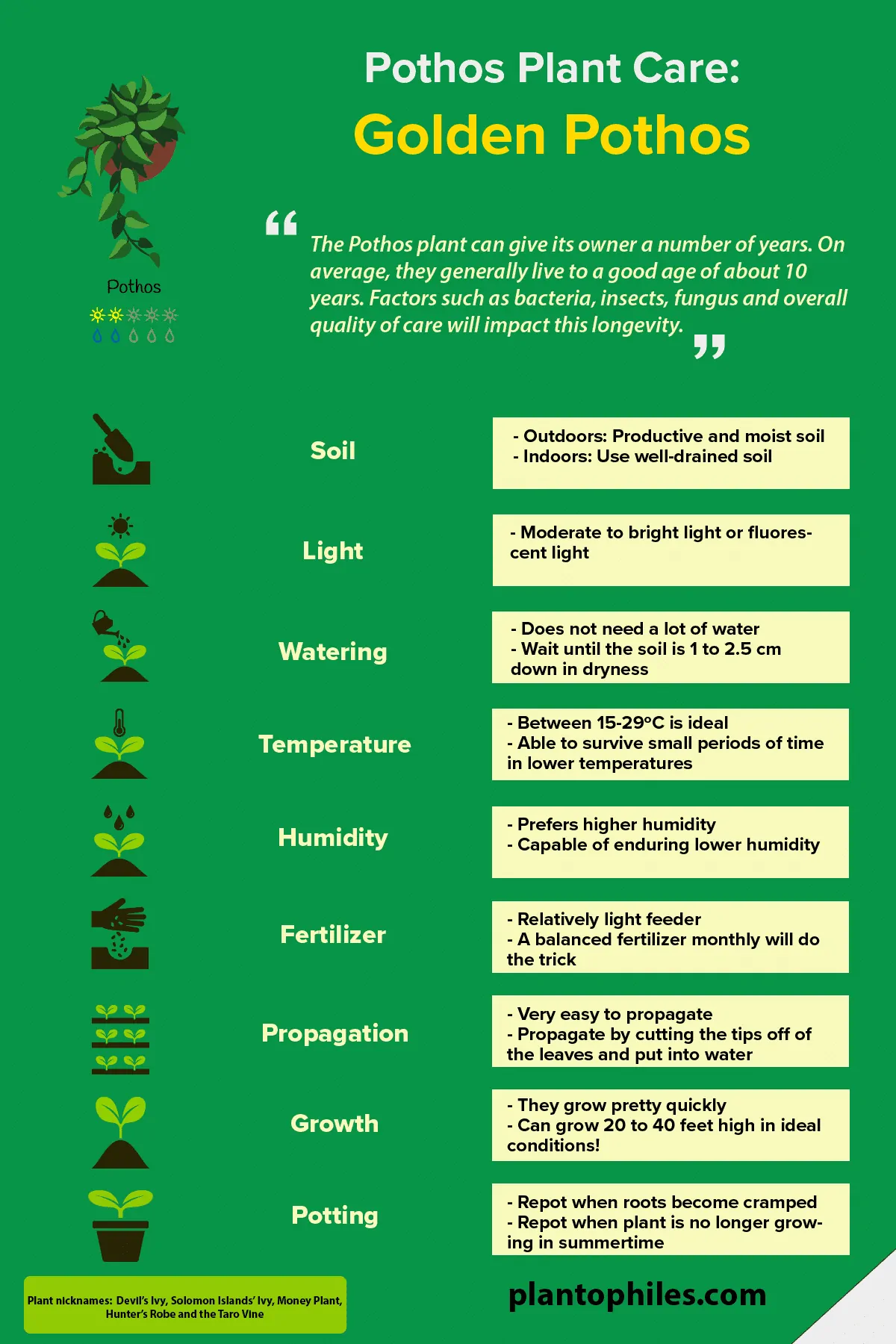Pothos or Epipremnum aureum by its botanical name is most commonly referred to as the Golden Pothos and is one of the easiest plants to care for. The name is associated with the leaves or foliage that are a mixture of green and yellow variegation. Pothos is a member of the Araceae or Aroid family of flowering plants.
It is probably the most common houseplant of all time and is loved for its resilience.
In this article, I am going to look at how I care for the pothos plant.
Table of Contents
Pothos Care Takeaways
| Species | Epipremnum aureum |
| Synonyms | Pothos, Golden Pothos, Devil’s Ivy,Solomon Islands’ Ivy, Money Plant, Hunter’s Robe, Taro Vine |
| Family | Araceae |
| Genus | Epipremnum |
| Growth | Climber |
| Height | 40 feet |
| Width | 6 feet |
| Soil | Potting mix or peat moss with added perlite or pumice |
| Watering | Water every to days |
| Light | Bright indirect |
| Temperature | 70 to 90°F |
| Humidity | 60-80% |
| Fertilizer | Fertilize times per month |
| Propagation | Stem cuttings |
| Toxicity | Toxic to humans, cats, and dogs. Contains calcium oxalate crystals. |
Pothos Care
To care for Pothos provide it with soil consisting of potting mix or peat moss with added perlite or pumice. The pH level should be between 6.0-6.5. This plant thrives best in bright indirect light but will tolerate lower light conditions. It prefers temperatures between 70-90 ºF (21-32ºC). Water when the top 1-2 inches become almost dry about once a week (2.5-5cm). Pothos tolerates humidity levels of 50% or lower but will thrive in humidity between 70-80%.
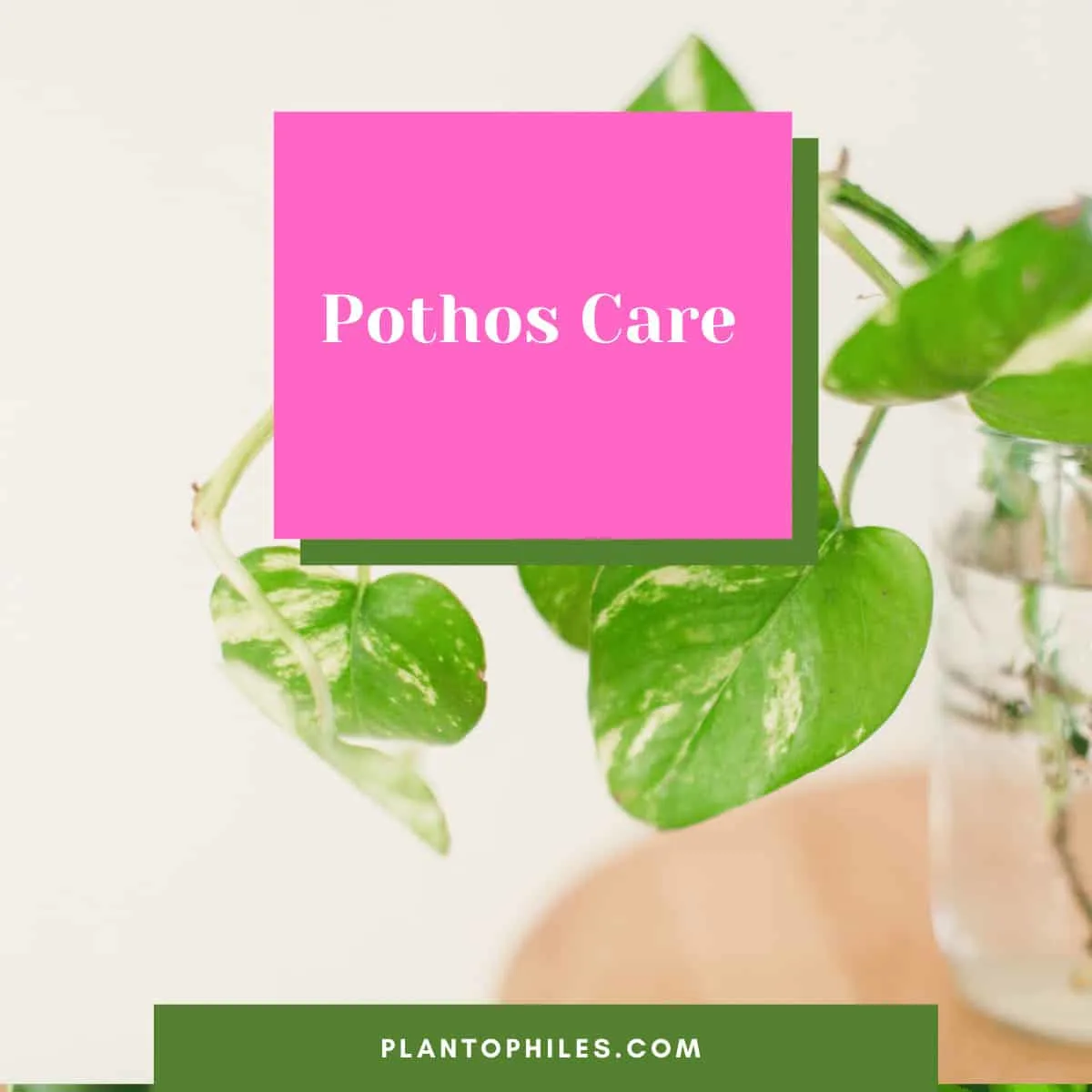
The Pothos Plant Growing Guide – Indoors
Members, such as the Golden Pothos, all share a modified leaf called the spathe. It is part of the inflorescence that consists of a spathe and the spadix, something most Aroids have in common.
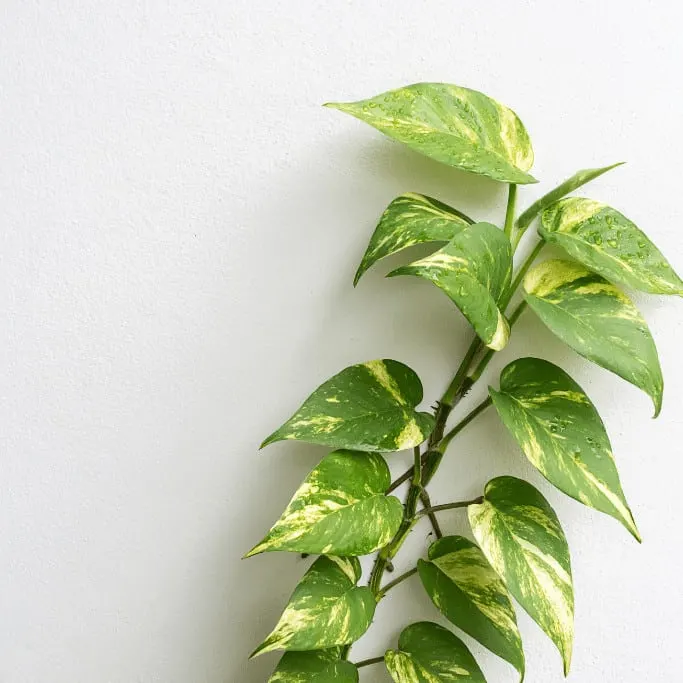
Pothos Plant care can be a real joy as these plants grow vigorously in many different conditions.
“The leaves of a Pothos are generally about 5 inches in length, though they can grow to be bigger in size when allowed to stretch out. This is why many botanists prefer to place them on an upright structure such as a totem or a mantle.”
Pothos Grow and Care Guide
Soil
Pothos prefers airy soil that drains well. You can use a general houseplant potting mix with added perlite or pumice.
Alternatively, you can use peat moss as a substitute for potting mix.
The pH level for Pothos soil should be between 6.0-6.5 in the slightly acidic to neutral range.
Light
The optimal lighting conditions for Pothos plants are moderate to bright light or fluorescent light at 5,000-foot candles (fc).
They have a reputation for growing in low-light conditions far away from windows and under fluorescent lighting in the office.
Based on personal experience I can testify that all of this is true. They tolerate low light but will not thrive.
They thrive under bright indirect light in an east, west, or north-facing window or under plant grow lights.
I once had a Pothos plant in a hallway in a hanging basket that got very little light and certainly no bright light.
The plant growth almost came to a halt and my Pothos was probably growing a new leaf every 6 months.
This is probably not what most plant owners aim for.
But if your only goal is just to keep your Pothos barely alive, yes you can provide it with almost low light conditions and it will not die.
It is also important to note that the leaves became almost fully green and the leaf size stayed small.
Watering
Water Pothos about once a week but only if the top 1-2 inches of soil are almost dry. Let the soil almost dry out between waterings.
Avoid overwatering and soggy soil as Pothos is prone to root rot.
Pothos plants do not like to be overwatered but they will survive if you forget them to water once or twice.
Keep in mind that less water is better than having a Pothos plant that is overwatered and develops root rot.
Interestingly they can survive and grow in water for years almost fully submerged with a couple of leaves underwater.
This is because only the combination of soil with water is leading to root rot in most cases.
The Pothos plant is popular with aquarists who want to get rid of nitrates in an aquarium produced by fish feces.
I myself grow a few Pothos plants in an indoor tank. I have the roots and the stems of my Pothos submerged so the roots can take in the nitrates and other nutrients.
Sine Pothos is a fast-growing plant, it is much more efficient in doing so compared to aquarium plants.
Temperature
Pothos prefers temperatures between 70-90 ºF (21-32ºC).
The minimum temperature should be 70 degrees ºF according to the University of Florida.
They will be able to survive small periods of time in lower temperatures as these are hardy plants but the growth will be stunted and longer periods may result in a dying Pothos plant.
If you live in colder weather, consider keeping your Pothos inside.
Humidity
The optimal humidity for Pothos is 70-90% but it will survive in a humidity of 50% or less without a problem. As a general rule of thumb provide Pothos with 50% or more.
The Pothos is known to prefer higher humidity, but this is not a necessity.
Just like the light requirements, these plants are capable of living in an environment with lower humidity.
Fertilizer
Fertilize Pothos every two weeks with a liquid fertilizer diluted to half-strength.
In terms of routine feedings, the Pothos plant is a relatively light feeder.
Fertilize less in the non-growing seasons.
Fertilize Pothos no more than once a month in autumn and winter.
Propagation
Propagate Pothos plants by taking stem cuttings. A stem consisting of a node and 1-2 leaves is best.
You cannot propagate a Pothos plant without a node. A leaf alone is not sufficient.
However pothos can be propagated without any leaves, but it will take much longer.
If you’re unsure about the practice of propagation, the Pothos is a great species to learn about, as they are incredibly easy to care for. It is best to begin propagation during the spring or summer, as this is the main growing season.
Growth
Pothos is a fast grower and can grow up to 40 feet high and 6 feet wide and the leaves can grow to 2 feet in size.
If you take good care of your Epipremnum aureum, you’ll see that they grow quite quickly compared to other houseplants.
Individuals that are grown outside, they can grow a whole foot in the months between December and May.
Potting
Repot pothos every 12 months in a pot with max. of 2 inches wider in diameter.
The only time that the act of repotting needs to take place is when the roots become cramped.
We are speaking of a Pothos plant becoming root-bound or pot-bound.
This occurs every few years. If you notice that your Pothos is no longer growing around spring and summertime, then consider repotting.
Pothos Plant Care Sheet
Caring for your own Pothos can be quite easy when you know the basics.
Here is a Pothos Care sheet:
Pothos Plant Care Problems and Solutions
Epipremnum aureum is an easy plant to grow, but there may be times when you see a problem regarding the Pothos plant care and you don’t know how to fix it.
We’ve taken the liberty of listing a few of the more common ailments found in these plants and what you can do to solve them.
Pothos Plant Care Problem: Fading Colors in the Leaves
Solution: The Pothos plant is quite talented when it comes to adapting, yet some conditions are just too extreme. If you notice that your leaves are becoming dull, then you may need to move them to a spot with more light. You can end up with fully green leaves if the light is low.
Pothos Plant Care Problem: Leaves Shift to Yellow and Fall Off
Solution: The yellowing of leaves is often a result of overwatering.
The best solution for a Pothos in this state is to check the bottom of your pot. If the drainage ports are free of any blockages, proceed to water your plant less often.
Pothos Plant Care Problem: Leaves Become Translucent or Scorched
Solution: If you can see through the middle section of your leaf, you may want to consider the amount of light that your plant is being exposed to.
Scorched leaves can also indicate that a Pothos is in sunlight that is direct. Fix this problem by moving your plant to a room with lower lighting.
Five Tips to Keep Your Pothos Alive
You might be nervous about the livelihood of your new plant. The Pothos plant care is not difficult. Follow these tips for a healthy addition to the home.
- If inside, place your Pothos in an area that does not have direct sunlight. For plants grown outdoors, provide ample cover.
- Make sure to water this plant every once in a while. Let it completely soak up all of the water before giving it more moisture, as they prefer dryer soil. Avoid making the roots soggy.
- When first planting your new houseplant, fill the pot with potting soil that is able to drain properly. Also occasionally check for blockages.
- Fertilizing a Pothos plant is not critical, but can help keep them healthy. Monthly feedings can be ideal during the winter. In the spring and fall, you may choose to add fertilizer every 2 weeks or so.
- Keep a close eye on the spacing of roots in your plant’s pot. If they seem cramped, you might need to propagate by cutting off the leaf’s edge and placing it in water until a new plant is grown.
Additional Tips and Tricks Regarding Pothos Plant Care
Now that you are fully aware of the general Pothos plant care involved in taking care, here are a few ways in which your plant can be truly happy and thriving.
Pothos Plant Care Tip #1
Putting your Pothos plant in a room with minimal direct sunlight can be advantageous. The bathroom or office is great since it typically has low light, which the Epipremnum aureum can handle.
Pothos Plant Care Tip #2
If you have a coveted variegated plant, chances are that you want to preserve the unique patterning. With higher variation in the coloring, these plants in a room that is well lit. This will reduce the risk of the leaves becoming duller.
Pothos Plant Care Tip #3
Some areas have placed the Pothos plant on the invasive species list. Do your research before investing in these individuals.
What does a Pothos Look Like?
The Pothos is a rather interesting plant with heart-shaped, or chordate leaves that continue to unfold as time goes on. The color of the leaves is primarily green with a splash of yellow, white, or some hue in between.
Many homeowners spruce up their living space with Epipremnum aureum for its versatility.
This plant can be displayed in an assortment of ways such as running up the side of a trellis or hanging in a basket.
Pothos Variegation
This type of houseplant is often desired for its variety in leaf color.
Some leaves tend to be completely green while others sport a mottling of white or cream-colored hues. Knowing the different variegations can give you a better idea of the plant you specifically want in your home.
Pothos Varieties
Traditional Golden Pothos
The most popular variety, the Golden Pothos is a heart-shaped leaf that is mostly green.
A mixture of green and white colors is splashed about unevenly to give it more of that creamy gold appearance.
If the proper requirements are met, the leaves will grow large at around 12 inches in width.
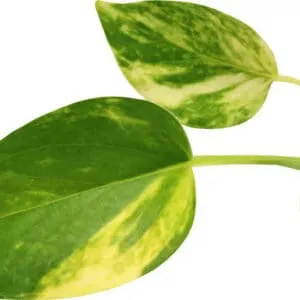
Marble Queen Pothos
Just as with the traditional variety, the leaves are heart-shaped with a blend of green and yellow pigmentation.
The difference lies in the shape of the leaf, which is typically narrower. The yellow mottling tends to also be more scattered rather than in blocks.
Neon Pothos
As the name suggests, the leaf of this variety is a bright yellow-green color.
Keep in mind that the leaves become brighter with age. They also tend to grow better in places with more light, as less sunlight will make them appear duller.
Pearls and Jade Pothos
One of the more unique varieties, these leaves has patches of white or silver. The lighter colors tend to hug the edges of the leaf, which are smaller than the other Pothos variegation.
Cebu Blue Pothos
Moving away from the iconic heart-shaped leaves, the Cebu Blue varieties tend to have leaves that are more arrow-like.
Unlike the other types, it also doesn’t have white patches or mottling. Instead, the leaves are a green color with a metallic shine.
The Origin of The Epipremnum Aureum
The Golden Pothos is often confused with another common houseplant, the Common Philodendron (Philodendron bipinnatifidum).
This is due to the fact that they both are originally native to areas in southeastern Asia. Many believe that it was from the Solomon Islands off of Papua New Guinea.
It moved on to other countries because people were fascinated with the colors of the leaves and how quickly they grew.
It is now considered an aggressive nonnative invader plant.
Pothos – One Plant, Many Names
When you go to the botanical store to pick up your new Pothos plant, you may be surprised by how many nicknames one plant alone has. It has also been labeled as the Devil’s Ivy, Solomon Islands’ Ivy, Money Plant, Hunter’s Robe, and the Taro Vine.
Golden Pothos Toxicity
According to the American Society for the Prevention of Cruelty to Animals ASCPA, Golden Pothos or Epipremnum aureum is toxic to cats and dogs.
It can lead to oral irritation and severe burning of the mouth. In addition, it might lead to vomiting and drooling.
Keep your critters away from ingesting this plant. It is also poisonous for humans and its sap leads to skin irritation as well as vomiting when ingested. Kids should not be allowed to be close to Golden Pothos.
Frequently Asked Questions About Pothos Plants
Why is Pothos called Devil’s Ivy?
The Pothos has a collection of names, just like any other plant. One of them, Devil’s Ivy was given for how quickly it can grow without being killed. In fact, it is so resilient that it will stay green even when deprived of light.
Do Pothos plants clean the air?
Pothos is great for air filtration. Some people even regard it as one of the best in terms of keeping your house clean of air pollutants. They do this by absorbing the toxins inside their leaves.
Why are the leaves on my Pothos plant turning yellow?
If you notice that the leaves are starting to shift to a more yellow hue, it might be related to water consumption. Remember how the Pothos plant prefers the soil to be slightly dry rather than drenched? When overwatered, they tend to show it through the coloration in their leaves, namely that yellowing.
Why does Pothos make a good houseplant?
Epipremnum aureum is a great addition to your home for a number of reasons. Other than keeping your air clean, they’re relatively low maintenance. They only require a low to medium level of light, seldom need watering, and are incredibly resilient. Another good reason is that they are easy to propagate.
Is the Pothos plant toxic to cats or other animals?
With the presence of calcium oxalates, these plants are indeed toxic to living beings. Typically they don’t cause much harm aside from the occasional irritation or vomiting. This includes any pets such as dogs or cats. If ingested, they will become sick yet will not die.
Conclusion About Pothos Care
To care for a Pothos plant:
- Soil: Potting mix or peat moss with added perlite or pumice
- pH: 6.0-6.5
- Light: Bright indirect
- Temperature: 70-90 ºF (21-32ºC)
- Watering: Water when the top 1-2 inches become almost dry (2.5-5cm) about once a week
- Humidity: 70-80%

Daniel has been a plant enthusiast for over 20 years. He owns hundreds of houseplants and prepares for the chili growing seasons yearly with great anticipation. His favorite plants are plant species in the Araceae family, such as Monstera, Philodendron, and Anthurium. He also loves gardening and is growing hot peppers, tomatoes, and many more vegetables.

